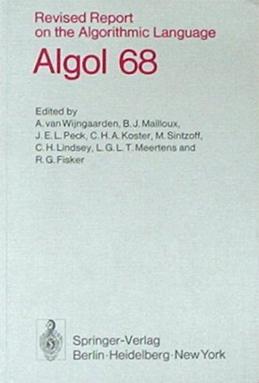
A programming language is a system of notation for writing computer programs. Programming languages are described in terms of their syntax (form) and semantics (meaning), usually defined by a formal language. Languages usually provide features such as a type system, variables, and mechanisms for error handling. An implementation of a programming language is required in order to execute programs, namely an interpreter or a compiler. An interpreter directly executes the source code, while a compiler produces an executable program.
Rebol is a cross-platform data exchange language and a multi-paradigm dynamic programming language designed by Carl Sassenrath for network communications and distributed computing. It introduces the concept of dialecting: small, optimized, domain-specific languages for code and data, which is also the most notable property of the language according to its designer Carl Sassenrath:
Although it can be used for programming, writing functions, and performing processes, its greatest strength is the ability to easily create domain-specific languages or dialects

A shell script is a computer program designed to be run by a Unix shell, a command-line interpreter. The various dialects of shell scripts are considered to be command languages. Typical operations performed by shell scripts include file manipulation, program execution, and printing text. A script which sets up the environment, runs the program, and does any necessary cleanup or logging, is called a wrapper.

A text editor is a type of computer program that edits plain text. An example of such program is "notepad" software. Text editors are provided with operating systems and software development packages, and can be used to change files such as configuration files, documentation files and programming language source code.
In a computer language, a reserved word is a word that cannot be used as an identifier, such as the name of a variable, function, or label – it is "reserved from use". This is a syntactic definition, and a reserved word may have no user-defined meaning.
In computer science, Backus–Naur form is a notation used to describe the syntax of programming languages or other formal languages. It was developed by John Backus and Peter Naur. BNF can be described as a metasyntax notation for context-free grammars. Backus–Naur form is applied wherever exact descriptions of languages are needed, such as in official language specifications, in manuals, and in textbooks on programming language theory. BNF can be used to describe document formats, instruction sets, and communication protocols.
Lexical tokenization is conversion of a text into meaningful lexical tokens belonging to categories defined by a "lexer" program. In case of a natural language, those categories include nouns, verbs, adjectives, punctuations etc. In case of a programming language, the categories include identifiers, operators, grouping symbols and data types. Lexical tokenization is related to the type of tokenization used in large language models (LLMs) but with two differences. First, lexical tokenization is usually based on a lexical grammar, whereas LLM tokenizers are usually probability-based. Second, LLM tokenizers perform a second step that converts the tokens into numerical values.
Programming style, also known as coding style, refers to the conventions and patterns used in writing source code, resulting in a consistent and readable codebase. These conventions often encompass aspects such as indentation, naming conventions, capitalization, and comments. Consistent programming style is generally considered beneficial for code readability and maintainability, particularly in collaborative environments.
In computer programming, indentation style is a convention, a.k.a. style, governing the indentation of blocks of source code. An indentation style generally involves consistent width of whitespace before each line of a block, so that the lines of code appear to be related, and dictates whether to use space or tab characters for the indentation whitespace.
Pretty-printing is the application of any of various stylistic formatting conventions to text files, such as source code, markup, and similar kinds of content. These formatting conventions may entail adhering to an indentation style, using different color and typeface to highlight syntactic elements of source code, or adjusting size, to make the content easier for people to read, and understand. Pretty-printers for source code are sometimes called code formatters or beautifiers.
Non-English-based programming languages are programming languages that do not use keywords taken from or inspired by English vocabulary.
The off-side rule describes syntax of a computer programming language that defines the bounds of a code block via indentation.

ALGOL 68 is an imperative programming language that was conceived as a successor to the ALGOL 60 programming language, designed with the goal of a much wider scope of application and more rigorously defined syntax and semantics.
In computer science, a relational operator is a programming language construct or operator that tests or defines some kind of relation between two entities. These include numerical equality and inequalities.
A whitespace character is a character data element that represents white space when text is rendered for display by a computer.
This comparison of programming languages compares the features of language syntax (format) for over 50 computer programming languages.

In computing, a script is a relatively short and simple set of instructions that typically automate an otherwise manual process. The act of writing a script is called scripting. Scripting language or script language describes a programming language that is used for scripting.

Rexx is a programming language that can be interpreted or compiled. It was developed at IBM by Mike Cowlishaw. It is a structured, high-level programming language designed for ease of learning and reading. Proprietary and open source Rexx interpreters exist for a wide range of computing platforms; compilers exist for IBM mainframe computers.
In computer programming languages, an identifier is a lexical token that names the language's entities. Some of the kinds of entities an identifier might denote include variables, data types, labels, subroutines, and modules.





